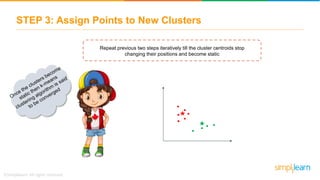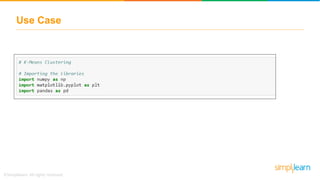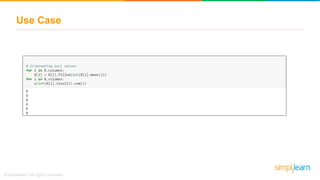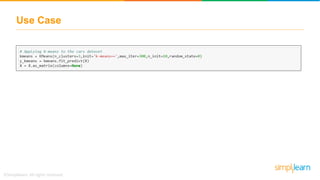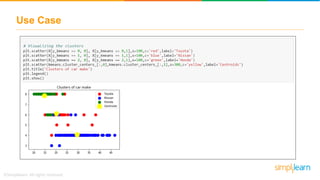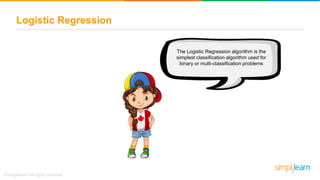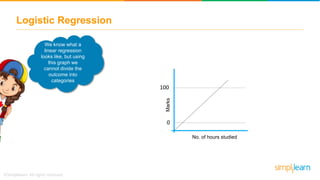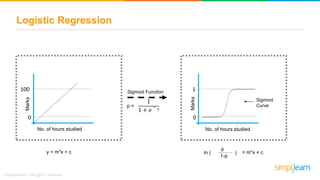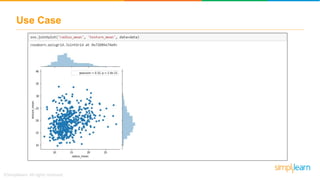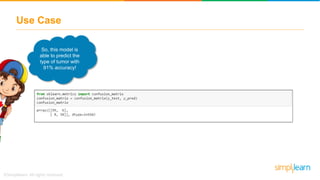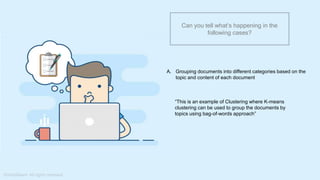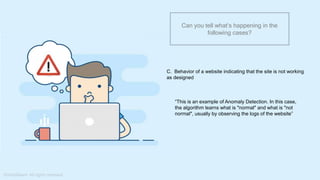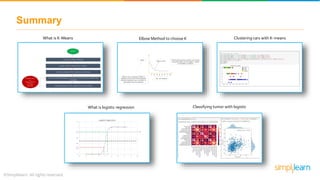Machine Learning Tutorial Part - 2 | Machine Learning Tutorial For Beginners Part - 2 | Simplilearn
- 1. Clustering What is Clustering? K-Means Clustering Flowchart to understand K-means Clustering Clustering of cars based on brands Logistic Regression What’s in it for you? What is Logistic Regression? Logistic Regression Curve & Sigmoid function Classify whether a tumor is malignant or benign based on features Cover/transition slides will be changed
- 2. Clustering Suppose, we have a pile of books of different genres!
- 3. Clustering Now, we divide them into different groups like Fiction Horror Educational
- 4. Well, organizing objects into groups based on their similarity is Clustering!
- 5. Well, organizing objects into groups based on their similarity is Clustering! K-means Clustering
- 6. K-Means Clustering is an example of Unsupervised learning
- 7. K-Means Clustering is an example of Unsupervised learning It is used when you have unlabeled data!
- 8. K-Means Clustering is an example of Unsupervised learning It is used when you have unlabeled data! To find clusters in the data based on feature similarity!
- 9. Steps for K-Means Suppose we have these data points and we want to assign them into clusters
- 10. STEP 1: Initialize Cluster Centroids We pick ‘K’ clusters & assign random centroids to clusters
- 11. STEP 1: Initialize Cluster Centroids We pick ‘K’ clusters & assign random centroids to clusters Then, we compute distance from objects to centroids
- 12. STEP 2: Compute Minimum Distance Now, we form new clusters based on minimum distance and calculate their centroids
- 13. STEP 3: Assign Points to New Clusters Repeat previous two steps iteratively till the cluster centroids stop changing their positions and become static
- 14. STEP 3: Assign Points to New Clusters Repeat previous two steps iteratively till the cluster centroids stop changing their positions and become static
- 15. Shall we see a flowchart to understand?
- 16. Flowchart to understand K-Means Choose K (Elbow Method) START Assign random centroids to clusters Compute distance from objects to centroids Yes Form new clusters based on minimum distance and calculate their centroids Compute distance from objects to new centroids Repeat until no observations change groups
- 17. Let’s see an example!
- 18. K-Means Algorithm Subject A B 1 1 1 2 1.5 2 3 3 4 4 5 7 5 3.5 5 6 4.5 5 7 3.5 4.5 Suppose, we have this dataset of 7 individuals and their score on two topics (A and B)
- 19. K-Means Algorithm Now, lets take two farthest-apart points as initial cluster centroids Subject A B 1 1 1 2 1.5 2 3 3 4 4 5 7 5 3.5 5 6 4.5 5 7 3.5 4.5
- 20. K-Means Algorithm Now, lets take two farthest-apart points as initial cluster centroids
- 21. K-Means Algorithm Each point is then assigned to the closest cluster with respect to their distance from the centroids Cluster 1 Cluster 2
- 22. K-Means Algorithm Now, we again calculate the centroids of each cluster: Individual Mean Vector (centroid) Cluster 1 1, 2, 3 (1.8, 2.3) Cluster 2 4, 5, 6, 7 (4.1, 5.4) Cluster 1 Cluster 2
- 23. K-Means Algorithm We compare each individual’s distance to its own cluster mean and to that of the opposite cluster. And we find: Individual Distance to mean (centroid) of Cluster 1 Distance to mean (centroid) of Cluster 2 1 1.5 5.4 2 0.4 4.3 3 2.1 1.8 4 5.7 1.8 5 3.2 0.7 6 3.8 0.6 7 2.8 1.1 Using Eucledian Distance between the points and the mean Cluster 1 Cluster 2
- 24. K-Means Algorithm Individual Distance to mean (centroid) of Cluster 1 Distance to mean (centroid) of Cluster 2 1 1.5 5.4 2 0.4 4.3 3 2.1 1.8 4 5.7 1.8 5 3.2 0.7 6 3.8 0.6 7 2.8 1.1 Only individual 3 is nearer to the mean of the opposite cluster (Cluster 2) than its own (Cluster 1) Cluster 1 Cluster 2 Moving point 3 to new cluster
- 25. K-Means Algorithm Thus, individual 3 is relocated to Cluster 2 resulting in the new partition: Individual Distance to mean (centroid) of Cluster 1 Distance to mean (centroid) of Cluster 2 1 1.5 5.4 2 0.4 4.3 3 2.1 1.8 4 5.7 1.8 5 3.2 0.7 6 3.8 0.6 7 2.8 1.1 Cluster 1 Cluster 2
- 26. K-Means Algorithm For the new clusters, we will find the actual cluster centroids: Individual Mean Vector (centroid) Cluster 1 1, 2, 3 (1.25, 1.5) Cluster 2 4, 5, 6, 7 (3.9, 5.1) Cluster 1 Cluster 2
- 27. K-Means Algorithm On comparing the distance of each individual’s distance to it’s own cluster mean and to that of the opposite cluster, we find that the data points are stable, hence we have our final clusters! Cluster 1 Cluster 2
- 28. K-Means Algorithm To find appropriate number of clusters in a dataset, we use elbow method: WSS No . of. clusters Elbow point Within sum of squares (WSS) is defined as the sum of the squared distance between each member of the cluster and its centroid Finding the optimal number of clusters using the elbow of the graph is called as the Elbow method
- 29. Use Case Using K-means clustering to cluster cars into brands using the parameters such as horsepower, cubic inches, make year, etc. Dataset: Cars data having information about 3 brands of cars namely Toyota, Honda, Nissan
- 30. Use Case
- 31. Use Case
- 32. Use Case
- 33. Use Case
- 34. Use Case
- 35. Use Case
- 36. Use Case
- 37. Use Case
- 38. Use Case
- 39. Clustering Today, we’ll dive into K- means Clustering! Well, organizing objects into groups based on their similarity is Clustering! Logistic Regression
- 40. Logistic Regression Now, let’s look into Logistic Regression
- 41. Logistic Regression The Logistic Regression algorithm is the simplest classification algorithm used for binary or multi-classification problems
- 42. Logistic Regression To brush up, y = mx+c The dependent variable is the target class variable we are going to predict In the previous tutorial, we learnt about Linear Regression, dependent and independent variables
- 43. Logistic Regression In the previous tutorial, we learnt about Linear Regression, dependent and independent variables The independent variables (x1…xn) are the features or attributes we are going to use to predict the target class To brush up, y = mx+c The dependent variable is the target class variable we are going to predict
- 44. Logistic Regression 1 0 Marks No. of hours studied We know what a linear regression looks like, but using this graph we cannot divide the outcome into categories 100
- 45. Logistic Regression 100 0 We know what a linear regression looks like, but using this graph we cannot divide the outcome into categories For example, a linear regression graph can tell us that with increase in number of hours studied, the marks of a student will increase But, it will not tell us whether the student will pass or not! Marks No. of hours studied
- 46. Logistic Regression In such cases, where we need the output as categorical value, we will use logistic regression! 100 0 No. of hours studied Marks
- 47. Logistic Regression 0 100 1 0 Sigmoid Curve Sigmoid Function y = m*x + c p = 1 1 + ⅇ − y p ln ( 1-p ) = m*x + c No. of hours studied No. of hours studied Marks Marks
- 48. Logistic Regression 0 0.2 0.4 0.6 0.8 1 1.2 0 1 2 3 4 5 6 7 8 9 Logistic Regression Threshold value Probability > 0.50 Value is rounded off to 1 indicating that the student will pass Probability < 0.50 , the value is rounded off to 0 indicating that the student will fail 0.30 0.82
- 49. Problem statement: To classify whether a tumor is ‘malignant’ or ‘benign’
- 50. Use Case
- 51. Use Case
- 52. Use Case
- 53. Use Case
- 54. Use Case
- 55. Use Case
- 56. Use Case
- 57. Use Case
- 58. Use Case
- 59. Use Case So, this model is able to predict the type of tumor with 91% accuracy!
- 60. Finally, let’s discuss the answers to the quiz asked in Machine Learning Tutorial Part-1 for the instructor
- 61. What do you understand from Measures and Dimensions? Each field from the data source is automatically assigned a datatype (such as string, integer) and a role (dimension or measure) Aggregation applied on measures is ‘Sum’ by default but you can always change the default aggregation in the settings Can you tell what’s happening in the following cases? A. Grouping documents into different categories based on the topic and content of each document “This is an example of Clustering where K-means clustering can be used to group the documents by topics using bag-of-words approach”
- 62. What do you understand from Measures and Dimensions? Each field from the data source is automatically assigned a datatype (such as string, integer) and a role (dimension or measure) Aggregation applied on measures is ‘Sum’ by default but you can always change the default aggregation in the settings Can you tell what’s happening in the following cases? B. Identifying hand-written digits in images correctly “This is an example of Classification. The traditional approach to solving this would be to extract digit dependent features like curvature of different digits, etc. and then use a classifier like SVM to distinguish between images”
- 63. What do you understand from Measures and Dimensions? Each field from the data source is automatically assigned a datatype (such as string, integer) and a role (dimension or measure) Aggregation applied on measures is ‘Sum’ by default but you can always change the default aggregation in the settings Can you tell what’s happening in the following cases? C. Behavior of a website indicating that the site is not working as designed “This is an example of Anomaly Detection. In this case, the algorithm learns what is "normal" and what is "not normal", usually by observing the logs of the website”
- 64. What do you understand from Measures and Dimensions? Each field from the data source is automatically assigned a datatype (such as string, integer) and a role (dimension or measure) Aggregation applied on measures is ‘Sum’ by default but you can always change the default aggregation in the settings Can you tell what’s happening in the following cases? D. Predicting salary of an individual based his/her years of experience “This is an example of Regression. This problem can be mathematically defined as a function between independent (years of experience) and dependent variable (salary of an individual)”
- 65. Summary What is K-Means Elbow Method to choose K Clustering cars with K-means Classifying tumor with logisticWhat is logistic regression














